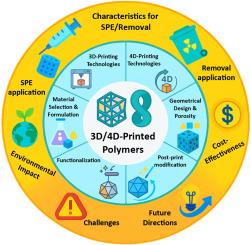3D和4D打印聚合物固相萃取和污染物去除应用
IF 12
1区 化学
Q1 CHEMISTRY, ANALYTICAL
引用次数: 0
摘要
解决全球环境挑战需要能够有效去除污染物和固相萃取的先进材料。本文综述了三维(3D)和四维(4D,刺激响应)打印方法制备聚合物的最新进展。它强调了3d打印结构如何提供可定制的几何形状,增加孔隙率和增强表面积,以提高吸附性能。此外,使用智能的4d响应聚合物可以在外部因素(如温度或pH值)触发时改变形状或控制释放,这增加了一个新的功能控制水平。我们评估了印刷技术,如熔融沉积建模、立体光刻、数字光处理和直接墨水书写,并比较了聚合物功能化、复合配方的策略,以及从复杂样品中去除重金属、有机污染物和药物残留的性能。这一全面的概述强调了科学的进步和仍然存在的挑战,指导未来可持续、高性能3D/4D打印聚合物材料的创新。本文章由计算机程序翻译,如有差异,请以英文原文为准。

3D and 4D printed polymers for solid phase extraction and pollutant removal applications
Addressing global environmental challenges calls for advanced materials capable of efficient pollutant removal and solid-phase extraction. This review examines recent developments in polymers fabricated by three-dimensional (3D) and four-dimensional (4D, stimuli-responsive) printing methods. It highlights how 3D-printed structures offer customizable geometries, increased porosity, and enhanced surface area to improve adsorption performance. In addition, using smart, 4D-responsive polymers allows for changes in shape or controlled release when triggered by outside factors (like temperature or pH), which adds a new level of functional control. We assess printing technologies, like fused deposition modelling, stereolithography, digital light processing, and direct ink writing, and compare strategies for polymer functionalization, composite formulation, and performance in removing heavy metals, organic pollutants, and pharmaceutical residues from complex samples. This comprehensive overview emphasizes both the scientific advances and remaining challenges, guiding future innovation in sustainable, high-performance 3D/4D printed polymer materials.
求助全文
通过发布文献求助,成功后即可免费获取论文全文。
去求助
来源期刊

Trends in Analytical Chemistry
化学-分析化学
CiteScore
20.00
自引率
4.60%
发文量
257
审稿时长
3.4 months
期刊介绍:
TrAC publishes succinct and critical overviews of recent advancements in analytical chemistry, designed to assist analytical chemists and other users of analytical techniques. These reviews offer excellent, up-to-date, and timely coverage of various topics within analytical chemistry. Encompassing areas such as analytical instrumentation, biomedical analysis, biomolecular analysis, biosensors, chemical analysis, chemometrics, clinical chemistry, drug discovery, environmental analysis and monitoring, food analysis, forensic science, laboratory automation, materials science, metabolomics, pesticide-residue analysis, pharmaceutical analysis, proteomics, surface science, and water analysis and monitoring, these critical reviews provide comprehensive insights for practitioners in the field.
 求助内容:
求助内容: 应助结果提醒方式:
应助结果提醒方式:


